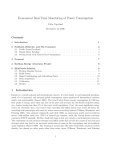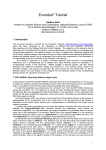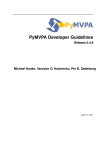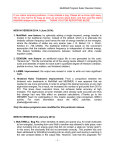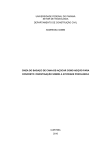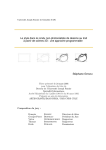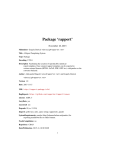Download Package `apricom`
Transcript
Package ‘apricom’ November 24, 2015 Title Tools for the a Priori Comparison of Regression Modelling Strategies Version 1.0.0 Date 2015-11-11 Maintainer Romin Pajouheshnia <[email protected]> Description Tools to compare several model adjustment and validation methods prior to application in a final analysis. Depends R (>= 3.1.1) Imports logistf, penalized, rms, graphics, stats, shrink Suggests knitr, testthat, rmarkdown License GPL-2 LazyData TRUE RoxygenNote 5.0.1 NeedsCompilation no Author Romin Pajouheshnia [aut, cre], Wiebe Pestman [aut], Rolf Groenwold [aut] Repository CRAN Date/Publication 2015-11-24 19:05:16 R topics documented: bootval . . . compare . . . compdist . . . datashape . . grandpart . . kcrossval . . loglikelihood loocval . . . . ml.rgr . . . . . . . . . . . . . . . . . . . . . . . . . . . . . . . . . . . . . . . . . . . . . . . . . . . . . . . . . . . . . . . . . . . . . . . . . . . . . . . . . . . . . . . . . . . . . . . . . . . . . . . . . . . . . . . . . . . . . . . . . . . . . . . . . . . . . . . . . . . 1 . . . . . . . . . . . . . . . . . . . . . . . . . . . . . . . . . . . . . . . . . . . . . . . . . . . . . . . . . . . . . . . . . . . . . . . . . . . . . . . . . . . . . . . . . . . . . . . . . . . . . . . . . . . . . . . . . . . . . . . . . . . . . . . . . . . . . . . . . . . . . . . . . . . . . . . . . . . . . . . . . . . . . . . . . . . . . . . . . . . . . . . . . . . . . . . . . . . . . . . . . . . . . . . . . . . . . . . . . 2 . 3 . 6 . 7 . 8 . 9 . 10 . 11 . 12 2 bootval ml.shrink . ols.rgr . . . ols.shrink . randboot . . randnor . . randpart . . randunif . . shrink.heur splitval . . . sse . . . . . strategy . . . . . . . . . . . . . . . . . . . . . . . . . . . . . . . . . . . . . . . . . . . . . . . . . . . . . . . . . . . . . . . . . . . . . . . . . . . . . . . . . . . . . . . . . . . . . . . . . . . . . . . . . . . . . . . . . . . . . . . . . . . . . . . . . . . . . . . . . . . . . . . . . . . . . . . . . . . . . . . . . . . . . . . . . . . . . . . . . . . . . . . . . . . . . . . . . . . . . . . . . . . . . . . . . . . . . . . . . . . . . . . . . . . . . . . . . . . . . . . . . . . . . . . . . . . . . . . . . . . . . . . . . . . . . . . . . . . . . . . . . . . . . . . . . . . . . . . . . . . . . . . . . . . . . . . . . . . . . . . . . . . . . . . . . . . . . . . . . . . . . . . . . . . . . . . . . . . . . . . . . . . . . . . . . . . . . . . . Index bootval . . . . . . . . . . . . . . . . . . . . . . . . . . . . . . . . . . . . . . . . . . . . . . . . . . . . . . . . . . . . . . . . . . . . . . . . . . . . . 13 14 15 16 17 17 18 19 20 22 23 24 Bootstrap-derived Shrinkage After Estimation Description Shrink regression coefficients using a bootstrap-derived shrinkage factor. Usage bootval(dataset, model, N, sdm, int = TRUE, int.adj) Arguments dataset a dataset for regression analysis. Data should be in the form of a matrix, with the outcome variable as the final column. Application of the datashape function beforehand is recommended, especially if categorical predictors are present. For regression with an intercept included a column vector of 1s should be included before the dataset (see examples). model type of regression model. Either "linear" or "logistic". N the number of times to replicate the bootstrapping process sdm a shrinkage design matrix. For examples, see ols.shrink int logical. If TRUE the model will include a regression intercept. int.adj logical. If TRUE the regression intercept will be re-estimated after shrinkage of the regression coefficients. Details This function applies bootstrapping to a dataset in order to derive a shrinkage factor and apply it to the regression coefficients. Regression coefficients are estimated in a bootstrap sample, and then a shrinkage factor is estimated using the input data. The mean of N shrinkage factors is then applied to the original regression coeffients, and the regression intercept may be re-estimated. This process can currently be applied to linear or logistic regression models. compare 3 Value bootval returns a list containing the following: raw.coeff the raw regression model coefficients, pre-shrinkage. shrunk.coeff the shrunken regression model coefficients lambda the mean shrinkage factor over N bootstrap replicates N the number of bootstrap replicates sdm the shrinkage design matrix used to apply the shrinkage factor(s) to the regression coefficients Examples ## Example 1: Linear regression using the iris dataset data(iris) iris.data <- as.matrix(iris[, 1:4]) iris.data <- cbind(1, iris.data) sdm1 <- matrix(c(0, 1, 1, 1), nrow = 1) set.seed(777) bootval(dataset = iris.data, model = "linear", N = 200, sdm = sdm1, int = TRUE, int.adj = TRUE) ## Example 2: logistic regression using a subset of the mtcars data data(mtcars) mtc.data <- cbind(1,datashape(mtcars, y = 8, x = c(1, 6, 9))) head(mtc.data) set.seed(777) bootval(dataset = mtc.data, model = "logistic", N = 500) compare A Comparison of Regression Modelling Strategies Description Compare two nested modelling strategies and return measures of their relative predictive performance Usage compare(model, Ntrials, strat1, strat2, data, Nrows, Ncomp, int = TRUE, int.adj, trim = FALSE, output = TRUE) Arguments model the type of regression model. Either "linear" or "logistic". Ntrials number of simulation trials. strat1 a list containing the strategy name and strategy-specific parameter values. This modelling strategy is taken as the reference for comparison. 4 compare strat2 a list containing the strategy name and strategy-specific parameter values. This modelling strategy is compared with the reference strategy, strat1. data a list describing the dataset in which the selected modelling strategies will be compared. If the first object in the list is "norm" or "unif", the user may submit parameters for generating multivariable simulated datasets (see details below. Users may specify their own dataset using the format list("dataset", user_data), where the second object in the list is their own dataset. Nrows the number of rows of observations in simulated datasets of type "norm" or "unif". Ncomp the number of rows of observations in the comparison set. This dataset is taken to represent the overall population, from which the training set is sampled. When data is of type "dataset", if Ncomp is not specified, the original data will be used as the comparison dataset. int logical. If int == TRUE an intercept will be included in the regression model. int.adj logical. If int.adj == TRUE the intercept will be re-estimated after shrinkage is applied to the regression coefficients. trim logical. If trim == TRUE a "trimmed" comparison distribution will be returned, along with a victory rate and median precision ratio derived using the trimmed distribution. The trimmed distribution only contains precision ratios within a range of plus or minus two times the interquartile range around the median precision ratio. output logical. If output == TRUE the function will return two graphical representations of the comparison distribution. Details This is the core function in the apricom package. The *compare* function can be used to compare the performance of two prediction model building approaches for either simulated or user-specified data. For further details, see the apricom user manual. The following strategies are currently supported: heuristic shrinkage ("heuristic"), split-samplederived shrinkage ("split"), cross-validation-derived shrinkage ("kcv"), leave-one-out cross-validationderived shrinkage ("loocv"), bootstrap-derived shrinkage ("boot") and penalized logistic regression using Firth’s penalty ("pml.firth"). Furthermore, models built using these methods may be compared with raw models fitted by ordinary least squares estimation ("lsq") or maximum likelihood estimation ("ml"). Strategies should be specified within the "strat1" and "strat2" arguments in the form of a list, starting with the strategy name (as listed above in parentheses), followed by relevant parameters for each respective method. For further details see individual help files for each strategy, and the examples below. Note that in the *compare* function call, the dataset should not be specified within the "strat1" or "strat2" arguments, and instead should only be called within the "data" argument. Value compare returns a list containing the following: VR the victory rate of strategy 2 over strategy 1. compare 5 MPR the median precision ratio over Ntrials comparison trials. PR.IQR the precision ratio interquartile range over Ntrials comparison trials. VR.trim if trim == TRUE the "trimmed" victory rate of strategy 2 over strategy 1 is returned. MPR.trim if trim == TRUE the "trimmed" median precision ratio over Ntrials comparison trials is returned. distribution the comparison distribution of strategy 2 vs. strategy 1. This is the distribution of precision ratios generated from Ntrials comparison trials distribution.trim if trim == TRUE the "trimmed" comparison distribution is returned. N.rejected the number of trials excluded from the comparison distribution by trimming strat1 modelling strategy 1 strat2 modelling strategy 2 shrinkage1 If strategy 1 is a shrinkage-after-estimation technique, a vector or matrix containing the shrinkage factor estimated in each trial is returned shrinkage1 If strategy 1 is a shrinkage-after-estimation technique, a vector or matrix containing the shrinkage factor estimated in each trial is returned Note When using compare it is strongly recommended that ideally 10000 comparison trials are used, to give stable estimates. Comparisons with logistic regression modelling model adjustment strategies are considerably slower than with linear regression, and 1000-5000 trials may be preferred. The examples provided in this documentation use considerably fewer comparison trials and yield highly unstable estimates. References Pestman W., Groenwold R. H. H., Teerenstra. S, "Comparison of strategies when building linear prediction models." Numerical Linear Algebra with Applications (2013) Examples ## ## ## ## Example 1: Comparison of heuristic formula-derived shrinkage against a raw least squares model. Data is simulated multivariable random normally distributed.The comparison set will have 2000 rows. Here only 10 trial replicates are used, but at least 1000 should be used in practice mu <- c(rep(0, 21)) rho <- 0.5 comp1 <- compare(model = "linear", Ntrials = 10, strat1 = list("lsq"), strat2 = list("heuristic", DF = 8), data = list("norm", mu, rho), Nrows = 200, Ncomp = 2000, int = TRUE, int.adj = FALSE, trim = FALSE, output = TRUE) ## Example 2: A truncated comparison of 10-rep, 10-fold 6 compdist ## ## ## ## cross-validation-derived shrinkage against leave-one-out cross-validation. Data is simulated multivariable random uniformly distributed (50 rows; 5 predictors with mean=0 ; r^2 = 0.7) The comparison set will contain 1000 observations. mu <- c(rep(0, 6)) rho <- 0.7 comp2 <- compare(model = "linear", Ntrials = 10, strat1 = list("loocv"), strat2 = list("kcv", k = 10, nreps = 10),data = list("unif", mu, rho), Nrows = 50, Ncomp = 1000, trim = TRUE) ## ## ## ## Example 3: Comparison of penalized logistic regression with Firth's penalty against raw logistic regression model using maximum likelihood estimation. Note that the logistf package is required for pml.firth. library(shrink) data(deepvein) dv.data <- datashape(deepvein, y = 3, x = 4:11) set.seed(123) comp4 <- compare(model = "logistic", Ntrials = 10, strat1 = list("ml"), strat2 = list("pml.firth"), data = list("dataset", dv.data), int = TRUE, int.adj = TRUE, trim = FALSE, output = TRUE) compdist Comparison Distribution Descriptives Description calculate a comparison distribution and associated descriptive statisics. Usage compdist(a, b, model, output, lambda1, lambda2, trim, strat1, strat2) Arguments a a vector containing the sum of square errors or -2 * log likelihood estimates derived using modelling strategy 1. b a vector containing the sum of square errors or -2 * log likelihood estimates derived using modelling strategy 2. model type of regression model. Either "linear" or "logistic". output logical. If output is TRUE the function will return two graphical representations of the comparison distribution. datashape 7 lambda1 a vector or matrix containing the estimated shrinkage factors derived using strategy 1 lambda2 a vector or matrix containing the estimated shrinkage factors derived using strategy 2 trim logical. If trim is TRUE a "trimmed" comparison distribution will be returned, along with a victory rate and median precision ratio derived using the trimmed distribution. The trimmed distribution only contains precision ratios within a range of plus or minus two times the interquartile range around the median precision ratio. strat1 a list containing the strategy name and strategy-specific parameter values. strat2 a list containing the strategy name and strategy-specific parameter values. Details This function works within compare to calculate the comparison distribution of strategy 2 against strategy 1. If trim == TRUE, a truncated distribution consisting of +/- 2 * interquartile range around the median precision ratio. The victory rate for linear regression is the left tail probability with a cut-off of 1. The victory rate for logistic regression instead taken at a cut-off of 0. For more details, refer to the accompanying PDF document. If output == TRUE the function will plot a histogram of the distribution and a scatterplot of the precision (SSE or -2 log likelihood) of strategy 2 against strategy 1. Points that lie below the red or blue line represent trials in which strategy 2 outperformed strategy 1 (the victory rate). Note For details of returned values and examples see compare. datashape Data shaping tools Description Generate a new dataset in a format that is accepted by compare. Dummy variables are created for categorical variables. Usage datashape(dataset, y, x, subs) 8 grandpart Arguments dataset a dataframe or matrix containing user data. y the column number of the outcome variable in dataset d. x a vector containing the explanatory or predictor variables of interest. The new data matrix will only contain these variables and the outcome variable. subs a vector describing a subset of rows from dataset d to include in the returned data matrix. Details This function can be used to prepare a dataset before applying the compare function. The outcome column number must be specified, and specific predictors and observation subsets may be specified. 2-level categorical variables will be converted to binary, while dummy variables will be created for categorical predictors with greater than two levels. The "datashaped" dataset should be saved to a new object. Value This function returns a matrix conforming to the specifications supplied to the datashape function. Warning datashape will not function if missing values are present. @examples ## Preparing the iris dataset data(iris) iris.shaped <- datashape(dataset = iris, y = 4) head(iris.shaped) ## Creating a copy of iris with sepal-related predictors and a subset of observations. iris.sub <- datashape(dataset = iris, y = 4, x = c(1,2), subs = c(1:20, 50:70)) head(iris.sub) grandpart Accessory Function for Cross-validation Description Randomly partition a dataset into k approximately equally sized partitions. Usage grandpart(dataset, k) Arguments dataset a dataset for partitioning. k the number of partitions; the cross-validation fold number. Value Returns a list containing the partitioned datasets. kcrossval 9 Note This function is not designed to be called directly, but acts within kcrossval kcrossval Cross-validation-derived Shrinkage After Estimation Description Shrink regression coefficients using a Cross-validation-derived shrinkage factor. Usage kcrossval(dataset, model, k, nreps, sdm, int = TRUE, int.adj) Arguments dataset a dataset for regression analysis. Data should be in the form of a matrix, with the outcome variable as the final column. Application of the datashape function beforehand is recommended, especially if categorical predictors are present. For regression with an intercept included a column vector of 1s should be included before the dataset (see examples) model type of regression model. Either "linear" or "logistic". k the number of cross-validation folds. This number must be within the range 1 < k <= 0.5 * number of observations nreps the number of times to replicate the cross-validation process. sdm a shrinkage design matrix. For examples, see ols.shrink int logical. If TRUE the model will include a regression intercept. int.adj logical. If TRUE the regression intercept will be re-estimated after shrinkage of the regression coefficients. Details This function applies k-fold cross-validation to a dataset in order to derive a shrinkage factor and apply it to the regression coefficients. Data is randomly partitioned into k equally sized sets. One set is used as a validation set, while the remaining data is used as a training set. Regression coefficients are estimated in the training set, and then a shrinkage factor is estimated using the validation set. This process is repeated so that each partitioned set is used as the validation set once, resulting in k folds. The mean of k shrinkage factors is then applied to the original regression coeffients, and the regression intercept may be re-estimated. This process is repeated nreps times and the mean of the regression coefficients is returned. This process can currently be applied to linear or logistic regression models. 10 loglikelihood Value kcrossval returns a list containing the following: raw.coeff the raw regression model coefficients, pre-shrinkage. shrunk.coeff the shrunken regression model coefficients. lambda the mean shrinkage factor over nreps cross-validation replicates. nFolds the number of cross-validation folds. nreps the number of cross-validation replicates. sdm the shrinkage design matrix used to apply the shrinkage factor(s) to the regression coefficients. Examples ## Example 1: Linear regression using the iris dataset ## 2-fold Cross-validation-derived shrinkage with 50 reps data(iris) iris.data <- as.matrix(iris[, 1:4]) iris.data <- cbind(1, iris.data) sdm1 <- matrix(c(0, 1, 1, 1), nrow = 1) kcrossval(dataset = iris.data, model = "linear", k = 2, nreps = 50, sdm = sdm1, int = TRUE, int.adj = TRUE) ## Example 2: logistic regression using a subset of the mtcars data ## 10-fold CV-derived shrinkage (uniform shrinkage and intercept re-estimation) data(mtcars) mtc.data <- cbind(1,datashape(mtcars, y = 8, x = c(1, 6, 9))) head(mtc.data) set.seed(321) kcrossval(dataset = mtc.data, model = "logistic", k = 10, nreps = 10) loglikelihood Negative 2 log likelihood Description Calculate the -2 * log likelihood of a dataset given a specified model. Usage loglikelihood(b, dataset) Arguments b intercept and coefficients of a generalized linear model. dataset a test dataset used to derive the likelihood. loocval 11 Value the function returns the -2 * log likelihood. Examples ## Using the mtcars dataset ## Resample, fit an ordinary least squares model and calculate likelihood data(mtcars) mtc.data <- cbind(1,datashape(mtcars, y = 8, x = c(1, 6, 9))) head(mtc.data) mtc.boot <- randboot(mtc.data, replace = TRUE) boot.betas <- ml.rgr(mtc.boot) loglikelihood(b = boot.betas, dataset = mtc.data) loocval Leave-one-out Cross-validation-derived Shrinkage Description Shrink regression coefficients using a shrinkage factor derived using leave-one-out cross-validation. Usage loocval(dataset, model, nreps = 1, sdm, int = TRUE, int.adj) Arguments dataset a dataset for regression analysis. Data should be in the form of a matrix, with the outcome variable as the final column. Application of the datashape function beforehand is recommended, especially if categorical predictors are present. For regression with an intercept included a column vector of 1s should be included before the dataset (see examples) model type of regression model. Either "linear" or "logistic". nreps the number of times to replicate the cross-validation process. sdm a shrinkage design matrix. int logical. If TRUE the model will include a regression intercept. int.adj logical. If TRUE the regression intercept will be re-estimated after shrinkage of the regression coefficients. Details This function applies leave-one-out cross-validation to a dataset in order to derive a shrinkage factor and apply it to the regression coefficients. One row of the data is used as a validation set, while the remaining data is used as a training set. Regression coefficients are estimated in the training set, and then a shrinkage factor is estimated using the validation set. This process is repeated so that each data row is used as the validation set once. The mean of the shrinkage factors is then applied 12 ml.rgr to the original regression coeffients, and the regression intercept may be re-estimated. This process may be repeated nreps times but each rep should yield the same shrunken coefficients. This process can currently be applied to linear or logistic regression models. Value loocval returns a list containing the following: raw.coeff the raw regression model coefficients, pre-shrinkage. shrunk.coeff the shrunken regression model coefficients. lambda the mean shrinkage factor over nreps cross-validation replicates. nreps the number of cross-validation replicates. sdm the shrinkage design matrix used to apply the shrinkage factor(s) to the regression coefficients. Note Warning: this method is not recommended for use in practice. Due to the high variance and inherent instability of leave-one-out methods the value of the shrinkage factor may be extreme. Examples ## Example 1: Linear regression using the iris dataset ## Leave-one-out cross-validation-derived shrinkage data(iris) iris.data <- as.matrix(iris[, 1:4]) iris.data <- cbind(1, iris.data) sdm1 <- matrix(c(0, 1, 1, 1), nrow = 1) set.seed(123) loocval(dataset = iris.data, model = "linear", sdm = sdm1, int = TRUE, int.adj = TRUE) ## Example 2: logistic regression using a subset of the mtcars data ## Leave-one-out cross-validation-derived shrinkage data(mtcars) mtc.data <- cbind(1,datashape(mtcars, y = 8, x = c(1, 6, 9))) head(mtc.data) set.seed(123) loocval(dataset = mtc.data, model = "logistic") ml.rgr Logistic Regression with Maximum Likelihood Estimation Description Fit a logistic regression model using maximum likelihood estimation ml.shrink 13 Usage ml.rgr(dataset) Arguments dataset a p x m data matrix, where the final column is a binary outcome variable. datashape may be applied to data so that the dataset is in the correct format for this function (see manual) Details This function is a wrapper for glm.fit, for convenient application within several functions in the apricomp package. This function may be called directly. For regression with an intercept included, the first column in the dataset must be a column of 1s. Value The function returns a column-vector containing the logistic regression coefficients and intercept (if specified). Examples ## Logistic regression using a subset of the mtcars data (outcome is "vs") data(mtcars) mtc.df <- mtcars[, c(8, 1, 9)] mtc.shaped <- datashape(dataset = mtc.df, y = 1) ml.rgr(mtc.shaped) ml.rgr(cbind(1,mtc.shaped)) ml.shrink Estimation of a Shrinkage Factor for Logistic Regression Description Estimate a shrinkage factor for shrinkage-after-estimation techniques, with application to logistic regression models. Usage ml.shrink(b, dat) Arguments b 1 x m matrix of regression coefficients, derived by resampling or sample-splitting dat a p x m data matrix, where the final column is a binary outcome variable. This dataset acts as a "test set" or "validation set". 14 ols.rgr Details This function works together with bootval, splitval, kcrossval and loocval to estimate a shrinkage factor. For further details, see References. This function should not be used directly, and instead should be called via one of the aforementioned shrinkage-after-estimation functions. Value the function returns a single shrinkage factor Note Currently, this function can only derive a single shrinkage factor for a given model, and is unable to estimate (weighted) predictor-specific shrinkage factors. References Harrell, F. E. "Regression modeling strategies: with applications to linear models, logistic regression, and survival analysis." Springer, (2001). Steyerberg, E. W. "Clinical Prediction Models", Springer (2009) ols.rgr Linear Regression using Ordinary Least Squares Description Fit a linear regression model using Ordinary Least Squares. Usage ols.rgr(dataset) Arguments dataset a p x m data matrix, where the final column is a continuous outcome variable. datashape may be applied to data so that the dataset is in the correct format for this function (see manual) Details This function may be called directly. For regression with an intercept included, the first column in the dataset must be a column of 1s. Value the function returns a column-vector containing the linear regression coefficients. ols.shrink 15 Examples ## Linear regression using a subset of the mtcars data (outcome is "wt") data(mtcars) mtc.df <- mtcars[, c(6, 1, 4)] mtc.shaped <- datashape(dataset = mtc.df, y = 1) ols.rgr(mtc.shaped) ols.rgr(cbind(1,mtc.shaped)) ols.shrink Estimation of a Shrinkage Factor for Linear Regression Description Estimate a shrinkage factor for shrinkage-after-estimation techniques, with application to linear regression models. Usage ols.shrink(b, dat, sdm) Arguments b 1 x m matrix of regression coefficients, derived by resampling or sample splitting dat a p x m data matrix, where the final column is a continuous outcome variable. This dataset acts as a "test set" or "validation set". sdm the shrinkage design matrix. This determines the regression coefficients that will be involved in the shrinkage process. Details This is an accessory function that works together with bootval, splitval, kcrossval and loocval to estimate a shrinkage factor. For further details, see References. This function should not be used directly, and instead should be called via one of the aforementioned shrinkage-after-estimation functions. Value the function returns a shrinkage factor. Note Currently, this function can only derive a single shrinkage factor for a given model, and is unable to estimate (weighted) predictor-specific shrinkage factors. 16 randboot References Harrell, F. E. "Regression modeling strategies: with applications to linear models, logistic regression, and survival analysis." Springer, (2001). Steyerberg, E. W. "Clinical Prediction Models", Springer (2009) Examples ## Shrinkage design matrix examples for a model with an ## intercept and 4 predictors: ## 1. Uniform shrinkage (default design within apricomp). sdm1 <- matrix(c(0, rep(1, 4)), nrow = 1) print(sdm1) ## 2. Non-uniform shrinkage; 1 shrinkage factor applied only to the ## first two predictors sdm2 <- matrix(c(0, 1, 1, 0, 0), nrow = 1) print(sdm2) randboot Bootstrap Resampling Description Generate a dataset from a given dataset using sampling with or without replacement. Usage randboot(dataset, n, replace = TRUE) Arguments dataset a p x m data matrix. n the number of rows of observations to be included in the new dataset. replace logical. If replace is TRUE sampling will be with replacement, thus returning a bootstrap replicate. Details This function is a simple shortcut for generating a bootstrap sample. It was originally designed for use within the comparison framework, but can be used as a stand-alone function. Value The function returns a new n x m matrix. The default is a bootstrap replicate of the orginal data. randnor 17 randnor Multivariable Random Normal data Description Generate a simulated multivariable random normally distributed dataset using the method of Cholesky Decomposition. Usage randnor(n, mu, Cov) Arguments n the number of rows of observations in the dataset mu a vector of length m containing the column means of the dataset Cov an m x m covariance matrix Value A simulated matrix of values based on the input parameters is returned. References Rizzo M. L., "Statistical Computing with R", Chapman & Hall/CRC (2007) Examples ## Simulated data based on the iris dataset mu <- c(rep(0, 4)) covmatr <- matrix(c(0.7, -0.04, 1.3, 0.5, -0.04, 0.2, -0.3, -0.1, 1.3, -0.3, 3.1, 1.3, 0.5, -0.1, 1.3, 0.6), ncol = 4) sim.dat <- randnor(n = 100, mu = mu, Cov = covmatr) head(sim.dat) randpart Accessory Function for Sample Splitting Description Randomly partition a dataset into a training set and a test set. Usage randpart(dataset, fract) 18 randunif Arguments dataset fract a dataset for splitting. the proportion of observations to be designated to the training set. Value Returns a list containing the training set and test set. Note This function is not designed to be called directly, but acts within splitval randunif Multivariable Random Uniform data Description Generate a simulated multivariable random uniformly distributed dataset using the method of Cholesky Decomposition. Usage randunif(n, mu, Cov, Q) Arguments n mu Cov Q the number of rows of observations in the dataset a vector containing the column means of the dataset a covariance matrix an optional orthogonal matrix Value A simulated matrix of values based on the input parameters is returned. References Rizzo M. L., "Statistical Computing with R", Chapman & Hall/CRC (2007) Examples ## Simulated data based on the iris dataset mu <- c(rep(0, 4)) covmatr <- matrix(c(0.7, -0.04, 1.3, 0.5, -0.04, 0.2, -0.3, -0.1, 1.3, -0.3, 3.1, 1.3, 0.5, -0.1, 1.3, 0.6), ncol = 4) sim.dat <- randunif(n = 100, mu = mu, Cov = covmatr) head(sim.dat) shrink.heur shrink.heur 19 Shrinkage After Estimation Using Heuristic Formulae Description Shrink regression coefficients using heuristic formulae, first described by Van Houwelingen and Le Cessie (Stat. Med., 1990) Usage shrink.heur(dataset, model, DF, int = TRUE, int.adj = FALSE) Arguments dataset a dataset for regression analysis. Data should be in the form of a matrix, with the outcome variable as the final column. Application of the datashape function beforehand is recommended, especially if categorical predictors are present. For regression with an intercept included a column vector of 1s should be included before the dataset (see examples) model type of regression model. Either "linear" or "logistic". DF the number of degrees of freedom or number of predictors in the model. If DF is missing the value will be automatically estimated. This may be inaccurate for complex models with non-linear terms. int logical. If TRUE the model will include a regression intercept. int.adj logical. If TRUE the regression intercept will be re-estimated after shrinkage of the regression coefficients. If FALSE the regression intercept will be reestimated as described by Harrell 2001. Details This function can be used to estimate shrunken regression coefficients based on heuristic formulae (see References). A linear or logistic regression model with an intercept is fitted to the data, and a shrinkage factor is estimated. The shrinkage factor is then applied to the regression coefficients. If int.adj == FALSE the intercept value is estimated as described in Harrell 2001.If int.adj == TRUE the intercept value will be re-estimated by refitting the model with the shrunken coefficients. The heuristic formula work by applying the number of model degrees of freedom (or the number of predictors) as a penalty, and so as the model becomes more complex, the necessary shrinkage increases, and the shrinkage factor becomes closer to zero. Value shrink.heur returns a list containing the following: raw.coeff the raw regression model coefficients, pre-shrinkage. shrunk.coeff the shrunken regression model coefficients 20 splitval lambda the heuristic shrinkage factor DF the number of degrees of freedom or number of predictors in the model Note Warning: In poorly fitting models that includea large number of predictors the number of degrees of freedom may approch or exceed the model chi square. In such cases the shrinkage factor will be very small or even negative, and a different model building strategy is recommended. References Harrell, F. E. "Regression modeling strategies: with applications to linear models, logistic regression, and survival analysis." Springer, (2001). Harrell, F. E., Kerry L. Lee, and Daniel B. Mark. "Tutorial in biostatistics multivariable prognostic models: issues in developing models, evaluating assumptions and adequacy, and measuring and reducing errors." Statistics in medicine (1996) 15:361-387. Steyerberg, E. "Clinical Prediction Models" Springer (2009) Van Houwelingen, J. C. and Le Cessie, S., "Predictive value of statistical models." Statistics in medicine (1990) 9:1303:1325. Examples ## Example 1: Linear regression using the iris dataset ## shrinkage using a heuristic formula data(iris) iris.data <- as.matrix(iris[, 1:4]) iris.data <- cbind(1, iris.data) set.seed(123) shrink.heur(dataset = iris.data, model = "linear") ## Example 2: logistic regression using a subset of the mtcars data ## shrinkage using a heuristic formula data(mtcars) mtc.data <- cbind(1,datashape(mtcars, y = 8, x = c(1,6,9))) head(mtc.data) set.seed(321) shrink.heur(dataset = mtc.data, model = "logistic", DF = 3, int = TRUE, int.adj = TRUE) splitval Split-sample-derived Shrinkage After Estimation Description Shrink regression coefficients using a split-sample-derived shrinkage factor. splitval 21 Usage splitval(dataset, model, nrounds, fract, sdm, int = TRUE, int.adj) Arguments dataset a dataset for regression analysis. Data should be in the form of a matrix, with the outcome variable as the final column. Application of the datashape function beforehand is recommended, especially if categorical predictors are present. For regression with an intercept included a column vector of 1s should be included before the dataset (see examples) model type of regression model. Either "linear" or "logistic". nrounds the number of times to replicate the sample splitting process. fract the fraction of observations designated to the training set sdm a shrinkage design matrix. For examples, see ols.shrink int logical. If TRUE the model will include a regression intercept. int.adj logical. If TRUE the regression intercept will be re-estimated after shrinkage of the regression coefficients. Details This function applies sample-splitting to a dataset in order to derive a shrinkage factor and apply it to the regression coefficients. Data are randomly split into two sets, a training set and a test set. Regression coefficients are estimated using the training sample, and then a shrinkage factor is estimated using the test set. The mean of N shrinkage factors is then applied to the original regression coeffients, and the regression intercept may be re-estimated. This process can currently be applied to linear or logistic regression models. Value splitval returns a list containing the following: raw.coeff the raw regression model coefficients, pre-shrinkage. shrunk.coeff the shrunken regression model coefficients lambda the mean shrinkage factor over Nrounds split-sample replicates Nrounds the number of rounds of sample splitting sdm the shrinkage design matrix used to apply the shrinkage factor(s) to the regression coefficients Examples ## Example 1: Linear regression using the iris dataset ## Split-sample-derived shrinkage with 100 rounds of sample-splitting data(iris) iris.data <- as.matrix(iris[, 1:4]) iris.data <- cbind(1, iris.data) sdm1 <- matrix(c(0, 1, 1, 1), nrow = 1) 22 sse set.seed(321) splitval(dataset = iris.data, model = "linear", nrounds = 100, fract = 0.75, sdm = sdm1, int = TRUE, int.adj = TRUE) ## Example 2: logistic regression using a subset of the mtcars data ## Split-sample-derived shrinkage data(mtcars) mtc.data <- cbind(1,datashape(mtcars, y = 8, x = c(1, 6, 9))) head(mtc.data) set.seed(123) splitval(dataset = mtc.data, model = "logistic", nrounds = 100, fract = 0.5) sse Sum of Square Errors Description Compute the sum of squared prediction errors (or residual sum of squares) when a linear model is applied to a dataset. Usage sse(b, dataset) Arguments b vector or column-matrix of regression coefficients dataset a matrix or dataframe. The final column is the outcome variable. Value The function returns the sum of square errors. Examples ## Using simulated data derived from the iris dataset mu <- c(rep(0, 4)) covmatr <- matrix(c(0.7, -0.04, 1.3, 0.5, -0.04, 0.2, -0.3, -0.1, 1.3, -0.3, 3.1, 1.3, 0.5, -0.1, 1.3, 0.6), ncol = 4) sim.dat <- randnor(n = 100, mu = mu, Cov = covmatr) sim.dat <- cbind(1, sim.dat) ## resample and fit an ordinary least squares model, and then ## calculate the sum of square errors of the model when applied ## to the original data sim.boot <- randboot(sim.dat, replace = TRUE) boot.betas <- ols.rgr(sim.boot) sse(b = boot.betas, dataset = sim.dat) strategy strategy 23 An Accessory Function for Strategy Selection Description This function acts as a switchboard for various regression modelling strategy, and links these strategies to compare. Usage strategy(g, method, int, int.adj, model) Arguments g a data matrix to which a modelling strategy will be applied. method a list containing the a regression modelling strategy name and strategy-specific parameter values. int logical. If int is TRUE an intercept will be included in the regression model. int.adj logical. If int.adj is TRUE the intercept will be re-estimated after shrinkage is applied to the regression coefficients. model the type of regression model. Either "linear" or "logistic". Details For further details, see compare. Value The object returned by strategy depends on the strategy selected in the call to compare. For example, if method[1] = "lsq", strategy will return a matrix of regression coefficients, whereas if method[1] = "boot", strategy will return a list containing values returned by bootval. Note This function is not designed to be called directly, but acts as a workhorse function for compare Index bootval, 2, 14, 15 compare, 3, 7, 8, 23 compdist, 6 datashape, 2, 7, 9, 11, 19, 21 glm.fit, 13 grandpart, 8 kcrossval, 9, 14, 15 loglikelihood, 10 loocval, 11, 14, 15 ml.rgr, 12 ml.shrink, 13 ols.rgr, 14 ols.shrink, 2, 9, 15, 21 randboot, 16 randnor, 17 randpart, 17 randunif, 18 shrink.heur, 19 splitval, 14, 15, 20 sse, 22 strategy, 23 24

























